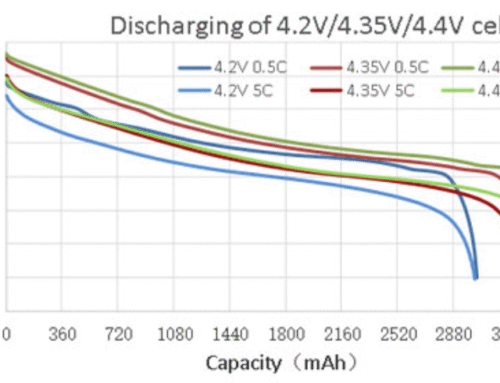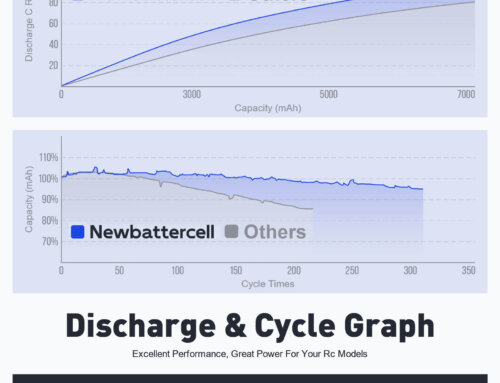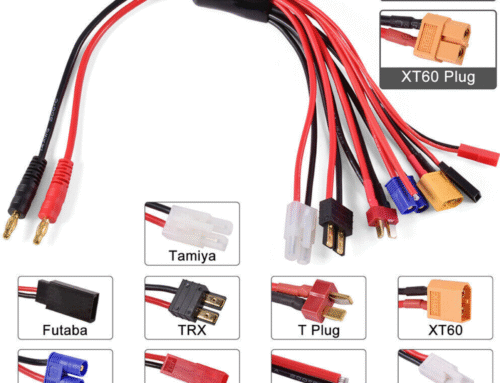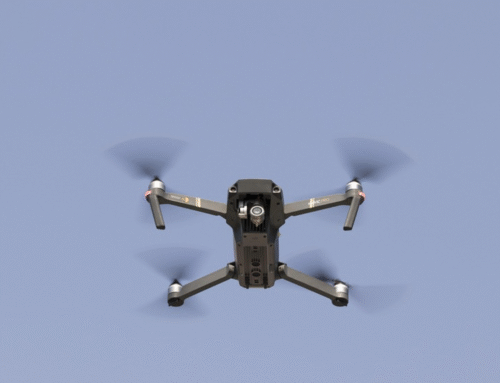What Are the Types of Drone Batteries? Comparison of Specifications, Capacity, Size, and Lifespan
Drones rely on high-performance batteries to achieve long endurance and reliable operation. With numerous drone models available on the market, selecting the right battery can significantly enhance efficiency. Understanding the differences between various battery types (such as Lithium Polymer (LiPo), Lithium-ion (Li-ion), Nickel-Cobalt-Manganese (NCM811), and Nickel-Metal Hydride (NiMH)) is crucial, as it impacts performance optimization, safety, and cost-effectiveness. This article provides a detailed introduction to the specifications, capacity, size, lifespan, and application scenarios of each type of drone battery.
Drone Batteries
1. Lithium Polymer (LiPo) Battery
Specifications and Characteristics:
- Voltage: 3.7V per cell (common configurations: 3S, 4S, 6S, 12S).
- Capacity: 1000–5000 mAh (higher for heavy-duty drones).
- Size and Weight: Lightweight and customizable (pouch-style design).
- Discharge Rate (C-rating): High (up to 100C for racing drones).
Advantages:
- High energy density: Stores more energy per gram, extending flight time (20–40 minutes for consumer drones).
- Lightweight: Suitable for agile and flexible drones (racing, aerial photography).
- Customizable shape: Adapts to unique drone designs.
Disadvantages:
- Sensitive and prone to damage: Overcharging or puncturing may cause swelling, fire, or explosion.
- Shorter lifespan: Approximately 300–500 charge-discharge cycles under optimal conditions.
Applicable Scenarios: Consumer drones, racing drones, lightweight professional applications.
2. Lithium-ion (Li-ion) Battery
Specifications and Characteristics:
- Voltage: 3.6–3.7V per cell (commonly 18650 cylindrical cells).
- Capacity: 2000–6000 mAh (higher for industrial drones).
- Size and Weight: Slightly heavier than LiPo but more compact.
- Discharge Rate: Medium (5–50C).
Advantages:
- Stable and safe: Low risk of thermal runaway (suitable for heavy-load scenarios).
- Longer lifespan: Approximately 500–1000 cycles with proper maintenance.
- Simple maintenance: No need for regular balancing.
Disadvantages:
- Lower energy density: Heavier than LiPo for the same capacity (100–150 Wh/kg).
- Slower discharge: Not suitable for high-power burst scenarios.
Applicable Scenarios: Industrial drones (medical delivery, agriculture), heavy-load applications, scenarios prioritizing safety over weight.
3. Nickel-Cobalt-Manganese 811 (NCM811) Battery
NCM811 is a subtype of Lithium-ion (Li-ion) battery, using a cathode material composed of 80% nickel, 10% cobalt, and 10% manganese. Compared to traditional lithium-ion chemistries (e.g., 18650 batteries with lower nickel content), this composition significantly increases energy density.
Key Characteristics of NCM811:
- Higher energy density: Up to 260–420 Wh/kg (compared to 150–200 Wh/kg for standard Li-ion), enabling longer flight times.
- Lightweight: Reduces overall drone weight, increasing payload capacity.
- Cost-effective: Lower cobalt content (an expensive and scarce material) makes it more affordable than older Li-ion variants.
Advantages:
- Extended range for mapping, surveying, or long-endurance inspection drones.
- Better thermal stability than earlier high-nickel chemistries (though careful thermal management is still required).
Disadvantages:
- Sensitive to overcharging or high temperatures, requiring advanced Battery Management Systems (BMS).
Applicable Scenarios: Professional drones requiring extended flight times (e.g., agricultural drones, aerial LiDAR systems) or commercial applications prioritizing payload and range.
4. Nickel-Metal Hydride (NiMH) Battery
Specifications and Characteristics:
- Voltage: 1.2V per cell (common configurations: 6–10 cells, 7.2–12V systems).
- Capacity: 600–3000 mAh (lower than LiPo/Li-ion).
- Size and Weight: Bulky and heavy.
- Discharge Rate: Low to medium (1–3C).
Advantages:
- Environmentally friendly: Free of toxic heavy metals (unlike NiCd).
- Durable: Resistant to impact and temperature changes.
Disadvantages:
- Low energy density: Short flight time (10–20 minutes, 60–100 Wh/kg).
- Memory effect: Charging before full discharge may reduce capacity.
Applicable Scenarios: Budget hobby drones, older models, applications where weight is not critical.
Core Parameters Comparison Table
| Battery Type | Energy Density (Wh/kg) | Cycle Life | Safety | Weight | Ideal Scenarios |
|---|---|---|---|---|---|
| LiPo | 150–200 | 300–500 | Medium | Lightweight | Consumer drones, racing |
| Li-ion | 100–150 | 500–1000 | High | Medium | Industrial drones, heavy-load applications |
| NiMH | 60–100 | 500–800 | High | Heavy | Hobby drones, low-cost projects |
| NCM811 | 260–420 | 800–1200 | High | Lightweight | Industrial drones |
How to Choose the Right Battery for Your Drone?
When selecting a drone battery, consider the following factors:
- Drone Purpose: Racing drones → LiPo; Industrial drones → Li-ion.
- Load Requirements: Heavy loads require high-capacity LiPo or Li-ion.
- Flight Time: Prioritize high-capacity (mAh) batteries (but balance with weight).
- Safety Needs: If concerned about thermal runaway, choose Li-ion or NiMH.
- Budget: NiMH/NiCd are cheaper but less efficient.
Maintenance Tips to Extend Battery Life
- LiPo: Store at 50–60% charge, avoid punctures, use fireproof bags.
- Li-ion: Avoid extreme temperatures, occasional full discharge is sufficient.
- NiMH/NiCd: Regularly fully discharge to mitigate memory effect.
Frequently Asked Questions (FAQs)
Q: Which battery type provides the longest flight time?
A: LiPo batteries, with their high energy density, typically provide 20–40 minutes of flight time for consumer drones.
Q: Are Li-ion batteries worth the extra cost?
A: Yes, especially for industrial scenarios where safety and durability are critical.
Q: Can a Li-ion battery replace a LiPo battery?
A: Only if the drone’s voltage and interface specifications match. Always consult the manufacturer.
Choosing a drone battery requires balancing power, weight, safety, and cost. LiPo dominates the consumer market with its high performance, while Li-ion/NCM811 leads in industrial applications. NiMH/NiCd remains suitable for niche scenarios but is gradually being phased out. Understanding these differences allows you to select a battery that matches your drone’s mission, ensuring reliable and long-lasting operation.
For professional guidance on customized battery solutions, feel free to contact Newbattercell, where expert engineers will tailor drone battery solutions to your needs!



